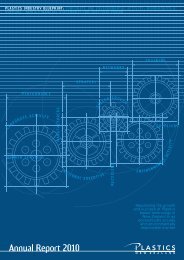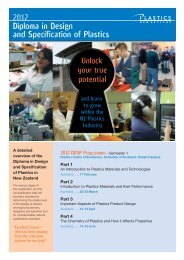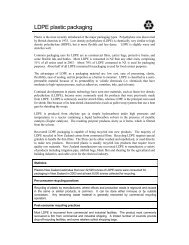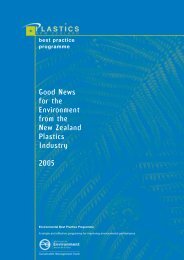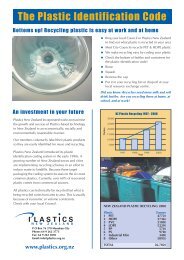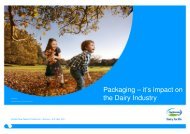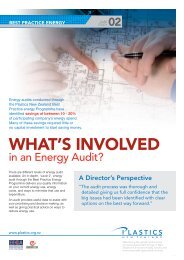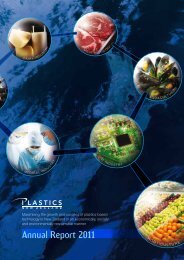Sustainable End-of-Life Options for Plastics in New Zealand
Sustainable End-of-Life Options for Plastics in New Zealand
Sustainable End-of-Life Options for Plastics in New Zealand
You also want an ePaper? Increase the reach of your titles
YUMPU automatically turns print PDFs into web optimized ePapers that Google loves.
5. Factors Influenc<strong>in</strong>g Recovery<br />
5.1 The Drivers<br />
There are a number <strong>of</strong> key drivers <strong>for</strong> material recovery, such as:<br />
• public demand <strong>for</strong> recycl<strong>in</strong>g<br />
• the <strong>New</strong> <strong>Zealand</strong> Waste Strategy<br />
• the requirement <strong>for</strong> Waste Management Plans <strong>in</strong> the Local Government Act 2002<br />
• <strong>in</strong>itiatives such as the Packag<strong>in</strong>g Accord and associated targets, backed up by Government’s<br />
preparedness to consider regulation should these prove <strong>in</strong>effective<br />
• multi-national companies operat<strong>in</strong>g <strong>in</strong> NZ be<strong>in</strong>g pushed to meet <strong>in</strong>ternational recovery<br />
benchmarks<br />
•recovered material as a potential resource as raw material prices <strong>in</strong>crease<br />
•procurement policies requir<strong>in</strong>g recycled content <strong>in</strong> products<br />
• prices <strong>of</strong>fered <strong>for</strong> recovered material,<br />
• the associated competition between commercial recyclers<br />
• lack <strong>of</strong> communication, and<br />
• <strong>in</strong>creas<strong>in</strong>g landfill charges, particularly <strong>for</strong> EPS.<br />
5.2 Lack <strong>of</strong> In<strong>for</strong>mation<br />
Discussions with manufacturers <strong>in</strong>dicate that there is material available <strong>for</strong> recovery but data on this<br />
is not collected and collated. More specific detail is needed, identify<strong>in</strong>g the sources and quantities <strong>of</strong><br />
the various product types (such as a breakdown <strong>of</strong> quantities <strong>of</strong> plastic packag<strong>in</strong>g by product type<br />
and typical disposal location). Schemes could then be arranged <strong>for</strong> commercial recyclers to collect<br />
the material from dispersed locations.<br />
5.3 Contam<strong>in</strong>ation<br />
5.3.1 Contam<strong>in</strong>ation at Source<br />
Recovery levels fall when the material is contam<strong>in</strong>ated. Pre-consumer <strong>in</strong>dustrial material is less likely<br />
to be contam<strong>in</strong>ated than post-consumer <strong>in</strong>dustrial and domestic material. There<strong>for</strong>e the scrap/rejects<br />
available <strong>for</strong> recovery at the pre-consumer stage (small amounts from numerous dispersed<br />
manufactur<strong>in</strong>g companies) will have a higher purity and, <strong>in</strong> turn, be more valuable to end-market<br />
customers. Post-consumer <strong>in</strong>dustrial material has a different source characteristic, <strong>in</strong> that there is<br />
more contam<strong>in</strong>ation <strong>in</strong>volved, but a greater amount <strong>of</strong> material available<br />
5.3.2 Contam<strong>in</strong>ation from Products<br />
Collected non-recyclable materials <strong>in</strong>cur landfill fees on disposal; there<strong>for</strong>e the sort<strong>in</strong>g stage is<br />
extremely important, as it is usually the last chance to remove any contam<strong>in</strong>ated material be<strong>for</strong>e the<br />
separated material is on-sold <strong>for</strong> reprocess<strong>in</strong>g.<br />
Factors Influenc<strong>in</strong>g Recovery<br />
36



